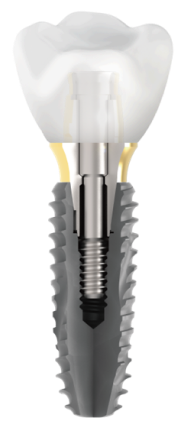

Crown (Artificial Tooth)
An artificial tooth restoration is completed by placing a crown to restore the function of the tooth.

Abutment
The abutment connects the crown and the fixture together with a screw.

Fixture
It is placed in the jawbone to act as a tooth root. The material of the implant artificial root is titanium, which is highly biocompatible and is used as a stable material that is harmless to the human body.
What is an Implant?
Implants are a dental technology that employs artificial structures similar to teeth, replacing or supporting missing teeth and gum tissue.
An implant typically consists of three main components: the fixture, abutment, and crown. The term "implant" usually refers to the fixture. It is an artificial structure that, once the fixture is placed in the jawbone where teeth are missing or have been extracted, connects to a prosthetic component to function similarly to a natural tooth. Implants are primarily made by titanium, a material with a specially treated surface. Titanium is highly biocompatible, allowing it to integrate well with surrounding dental tissues, thus effectively replicating the function and stability of a tooth root.




